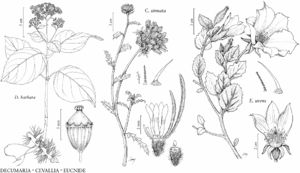Cevallia
Varied. Ci. 2(4): 35. 1805.
| Taxon | Illustrator ⠉ | |
|---|---|---|
 | Eucnide urens Cevallia sinuata Decumaria barbara | Linny Heagy Linny Heagy Yevonn Wilson-Ramsey |
Herbs or subshrubs, perennial; trichomes (1) pointed with surfaces ± smooth, knobby, or notched, (2) retrorsely barbed along shaft and at apex, (3) dendritic, and (4) stinging. Stems erect, sometimes becoming decumbent. Leaves cauline; petiole present or absent; blade ovate-elliptic, lobed, margins entire. Inflorescences headlike thyrses; peduncle to 1 dm. Pedicels not elongating in fruit. Flowers: hypanthium adnate to ovary proximally, free distally; perianth whorls similar; sepals white to yellowish abaxially, yellow adaxially, distinct, linear-lanceolate, longer than petals; petals white to yellowish abaxially, yellow adaxially, distinct, linear-lanceolate, spreading, both surfaces densely hairy; nectary absent; stamens 5, included; filaments monomorphic, dorsiventrally flattened, linear, shorter than anthers; anthers with distal connective extension; staminodes absent; pistil pseudomonomerous, placenta subapical; stigma ovoid, 3–5-lobed, densely hairy. Fruits cypselae, urceolate-ovoid, straight; sepals and petals persistent. Seeds 1, ovoid. x = 7.
Distribution
sw United States, n Mexico
Discussion
Species 1.
In subfam. Gronovioideae, Cevallia is sister to a clade consisting of Fuertesia and Gronovia.
The distinctive stamens, which have inflated, tonguelike extensions beyond the pollen sacs, are unique in the family.
Selected References
None.
Lower Taxa
"not elongating" is not a number."dm" is not declared as a valid unit of measurement for this property.